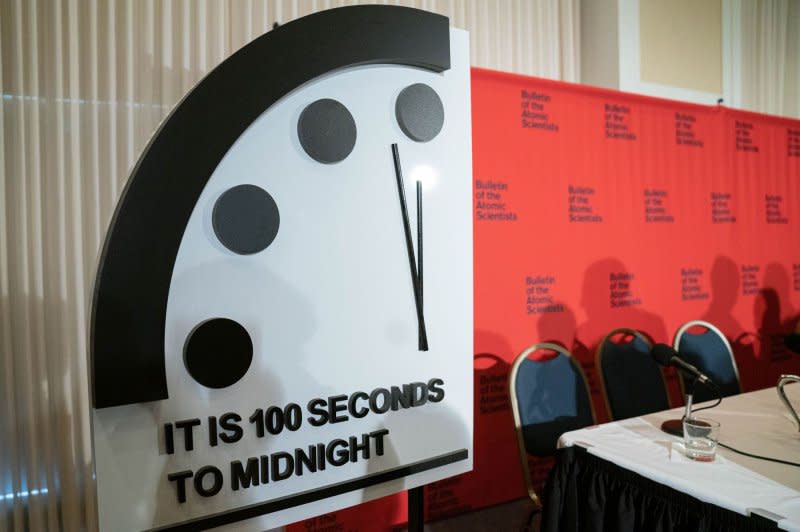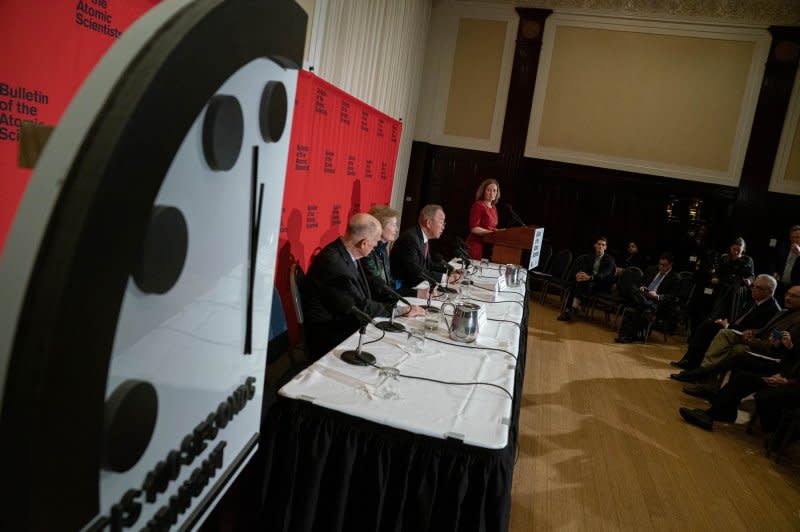Symbolic 'Doomsday Clock' signals continued risk of global catastrophe

Jan. 23 (UPI) -- Because of current world events and turmoil, the Bulletin of the Atomic Scientists' "Doomsday Clock" on Tuesday remains close to midnight, signaling a dangerous potential risk of global catastrophe.
Citing "ominous trends," the report says the symbolic clock remains at 90 seconds before midnight.
Among some of the dangers raised by the report are climate change, artificial intelligence, nuclear threats related to the ongoing war between Russia and Ukraine, and the escalation of diplomatic tensions between China and the United States.
Created in 1947 by Albert Einstein and J. Robert Oppenheimer, the "Doomsday Clock" is a public warning about the threats posed by nuclear weapons and other factors that represent how close the human race is to potentially destroying the world with manmade technology.
The furthest the clock has been set was 17 minutes to midnight after the collapse of the Soviet Union in 1991. In 2023, the clocked moved the closest it had ever been to the point of annihilation, the current 90 seconds to midnight.

In announcing the news Tuesday, the Bulletin of the Atomic Scientists said it did so because "humanity continues to face an unprecedented level of danger."
"Our decision should not be taken as a sign that the international security situation has eased," the report's authors said. "Instead, leaders and citizens around the world should take this statement as a stark warning and respond urgently, as if today were the most dangerous moment in modern history. Because it may well be."
Recent news events and other analyses have supported that conjecture.
A new report by the World Economic Forum said world nations are facing the growing threat from extreme weather, artificial intelligence and geopolitical tumult. Artificial Intelligence has "great potential to magnify disinformation and corrupt the information environment on which democracy depends."
"Military uses of AI are accelerating. Extensive use of AI is already occurring in intelligence, surveillance, reconnaissance, simulation, and training," according to The Bulletin. "Of particular concern are lethal autonomous weapons, which identify and destroy targets without human intervention. Decisions to put AI in control of important physical systems -- in particular, nuclear weapons -- could, indeed, pose a direct existential threat to humanity."
Aside from emerging threats such as AI and climate, the threat of nuclear devastation remains noteworthy as it was before, according to the report.
The report's authors cited how Iran continues to enrich uranium to close to weapons grade as it continues "stonewalling" the International Atomic Energy Agency on important points. And they noted how Pakistan and India continue to expand their nuclear programs "without pause or restraint."
Recent news events have highlighted the potential threat brought by different nations' nuclear aspirations, too.
North Korea recently test fired a new solid-fuel ballistic missile which traveled over 310 miles before landing in the East Sea. In January 2023, the World Health Organization updated its list of medicine to stockpile for a nuclear emergency.
In December, Russia completed its delivery of nuclear weapons to Belarus. The same month, the US Department of State said Iran had increased its production of enriched uranium by 60%.
The Doomsday Clock's time is determined by atomic scientists associated with the group, as well as a board of sponsors, which includes nine Nobel laureates.

